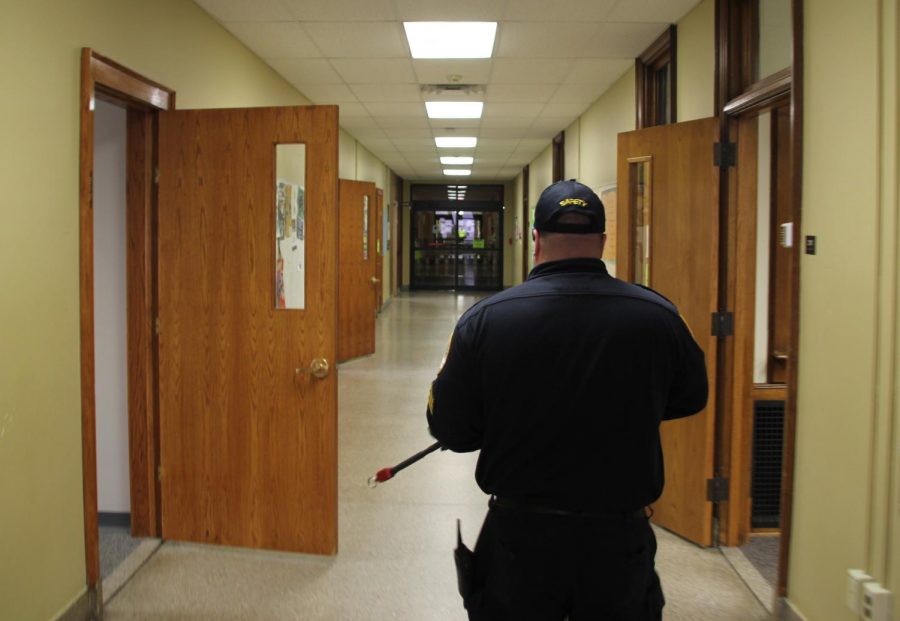Protocol followed in LAC during active shooter drill; delayed reaction throughout rest of campus
April 27, 2018
Members of the Marywood community practiced what to do in a real-life active shooter situation on Wednesday, April 25 in the Liberal Arts Center (LAC). This was the first active shooter drill Marywood held in 2018.
Before this drill in the spring semester, the university held one other active shooter drill and presentation during winter break last December and advised the Marywood community on what to do during an active shooter situation.
Throughout the spring semester, the Safety Implementation Task Force held open presentations for faculty, support staff and students to prepare for a drill.
Chief of Campus Safety Mike Pasqualicchio sent emails informing students and staff about the drill with an attached video on what to do in an active shooter situation. He included active shooter safety tips depending on where a person is located when an alert is issued. For people in the same building as the shooter, he advised students to run, hide or fight. Pasqualicchio recommended people should secure themselves in a safe area if they are not in the same building as the shooter.
A gunman started the drill by firing blank rounds on the first floor of the Rotunda in the LAC. Marywood sent an E2Campus text alert at 1:16 p.m. that emphasized the scenario was a drill and said an active shooter was reported in the LAC. The alert said to exit the building if possible or shelter in place.
The gunman went door to door trying to gain entry to classrooms. He continued to fire shots and yelled “where’s he at?” and “I know you’re here” to make the situation more realistic.
A follow-up E2Campus alert announced the all clear eight minutes later when the drill concluded.
At the time of the drill, four classes were in session out of six that typically meet at that time in the building. The professors and students in LAC classrooms turned off the lights and locked their classroom doors. Students in one class that had a door with a window hid in the back corner.
The Wood Word stationed reporters around campus to see the reactions of students in various different locations and classrooms outside the LAC.
In the Shields Center for Visual Arts, one class closed and locked the door after a student noticed the text alert a few minutes before the drill concluded. A class in the Center for Natural and Health Sciences took precautions by moving away from windows, securing the door with a belt and turning off the lights.
In the Learning Commons, students did not immediately react when receiving the text alert. Safety Committee Member Kevin Kuna instructed students in the lobby to hide, seek shelter and make sure they weren’t visible on the main floor of the building.
Kuna said he thinks students reacted slowly because it was a drill.
“Hopefully in real life circumstances now they know to actually move, shelter, and hide in place,” he said.
Students respond to the drill
Freshman Speech Pathology Major Paige Bell was in the Learning Commons and went downstairs after hearing Kuna. She said she and her friend Freshman Speech Pathology Major Carly Arnold were sitting at a table until they heard Kuna’s instructions.
“We didn’t really know what to do because no one else was moving,” Arnold said.
Freshman Accounting Major Omar Ramos was also in the Learning Commons at the time of the drill. He said he “didn’t really know what to do.”
“I guess the severity of it was just like I didn’t know what to do period for the drill. It wasn’t really in my head like, ‘Oh my God, you have to hide.’ I’m pretty sure if it was real I would’ve just ran,” he said.
Junior Music Education Major Jerome Nidoh, who was in a classroom in the LAC during the drill, said it was “attention–grabbing” when the shooter yelled and fired shots. His class locked the door and sheltered in place.
Junior Business Management Major Amber Shirk was also in a classroom in the LAC during the drill and described the experience as “nerve-wracking.”
“It was kind of scary to think about what would have actually happened in a real situation,” she said.
Her class locked the door and closed the blinds. Shirk said she knew the drill was happening, but heard different things from other professors and students about the details and was not sure what to expect.
Sophomore English Major Sydney Toy and Junior Nutrition Major Taylor Schirra were in a class in the LAC that hid in the back of the room away from the door. They both knew it was a drill, but said they were still scared.
Toy and Schirra said a student in their class mentioned that the drill was happening before class started and the professor and students formed a plan for when they would receive the text alert.
Safety Implementation Task Force calls drill a success
Marywood Campus Safety Sergeant Kyle Miller acted as the shooter in the drill. Miller is an active shooter trainer and has completed ALICE training, which is an acronym for “alert, lockdown, inform, counter, evacuate” and is a national training institute that promotes “proactive strategies to improve the chances of survival during an active shooter event,” according to its website.
Miller said from his perspective, everyone in the LAC followed procedures. He hopes students take this as a learning experience.
“It’s more and more prevalent these days, and we’re doing this to make it more of a learning experience just to be prepared in case something does happen,” he said.
Assistant Vice President for Building and Grounds and Safety Implementation Task Force Chair Wendy Yankelitis said she considered the drill a success. She said students sheltered in place or locked classroom doors, which was the right thing to do in the situation.
According to Yankelitis, she sent individual emails to the professors teaching in the LAC during the time of the drill explaining the scenario and giving them advice. She said she wished more students were in the building to participate in the drill.
“I think the more students we get exposed to something like this kind of drill, that’s the goal of it,” she said. “I think the best way to learn is really be part of the drill.”
Yankelitis said although it’s unfortunate that more students were not present in the LAC, there will be more drills to incorporate all of campus. She added that she hopes this drill encourages students to attend active shooter presentations.
Pasqualicchio said the drill’s participants got to experience the sounds of gunfire and learn how to react to an active shooter.
He added that in the future, he sees these drills happening more frequently.
“I see that coming down the line that a requirement might be in place where you have to do an active shooter drill every year in every building,” he said.
Pasqualicchio said he thinks the university is going in a positive direction in regard to informing and training students about how to react in emergency situations. However, he said even with training, it doesn’t mean a person will know how to react to various disaster situations.
“We’re improving, but these kind of scenarios change every day. Every incident is different, so we have to adjust to what’s happening around us,” he said.
Pasqualicchio said he is looking at additional training in the future from outside agencies. Over the summer, Pasqualicchio and the Safety Committee will be planning more training to involve additional members of the Marywood community.
Follow The Wood Word for more updates.
Autumn Bohner, John Ferraro, Justin Kucharski, Briana Ryan, Tatiana Tell, Bethany Wade, Alex Weidner, Erin Yeager and Anne Zukowski contributed to this article.
Contact the writer: [email protected]
Twitter: @RLookerTWW





